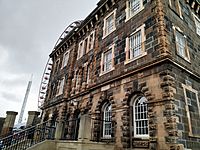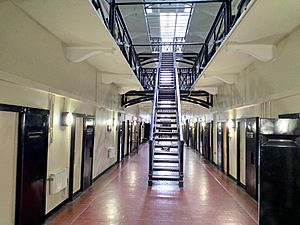HM Prison Crumlin Road facts for kids
 |
|
| Location | Belfast, Northern Ireland |
|---|---|
| Status | Museum |
| Security class | High |
| Capacity | Variable |
| Opened | 1846 |
| Closed | 31 March 1996 |
HMP Belfast, also known as Crumlin Road Gaol, is a former prison situated on the Crumlin Road in north Belfast, Northern Ireland. Since 1996 it is the only remaining Victorian era prison in Northern Ireland. It is colloquially known as the Crum.
The Northern Ireland Environment Agency has given it a grade A listed building status because of its architectural and historical significance. The Crumlin Road Courthouse, derelict since it closure, stands opposite the Gaol with a tunnel under the main road connecting the two buildings and used previously to transport the prisoners between both buildings.
Early history
Designed by Sir Charles Lanyon, the prison was built between 1843 and 1845 and cost £60,000. Built as a replacement for the County Gaol on Antrim Street in Carrickfergus, and known as the County Gaol for Antrim, it was constructed of black basalt rock on ten acres at the bottom of the Crumlin Road. Partly based on HM Prison Pentonville, it was one of the most advanced prisons of its day. Built within a five-sided wall, the four wings are up to four storeys in height and fan off from the central area which was known as The Circle. The prison was originally built to hold between 500 and 550 prisoners in cells that measured 12 x 7 feet, (365 cm x 213 cm) It was the first prison in Ireland to be built according to "The Separate System", intended to separate prisoners from each other with no communication between them. Later, especially in the early 1970s, as many as three prisoners were placed in each cell.
The first 106 inmates, who were forced to walk from Carrickfergus Prison in chains, arrived in 1846. These inmates, who were men, women and children, completed the changeover of the two prisons. Children from impoverished working-class families were often imprisoned at the gaol in the early years for offences such as stealing food or clothing.
Women inmates were kept in the prison block house until the early 1900s. Ulster suffragettes, among them Dorothy Evans and Madge Muir, were imprisoned in the gaol during 1914.
The gaol closed its doors as a prison in 1996 and it was empty for many years. A restoration project was announced in August 2010. In November 2012, the prison opened as a tourist attraction and conference centre and now hosts concerts. The museum welcomed a visit by Queen Elizabeth II in 2014.


